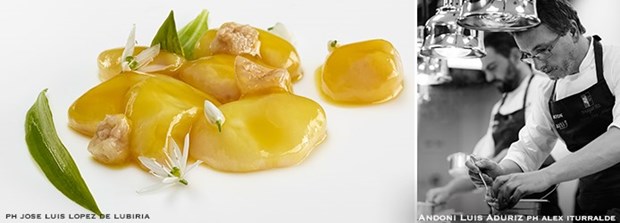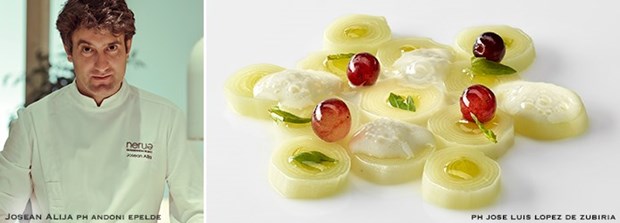Pil-pil, vizcaina, green sauce and black sauce: from classic recipes to modern interpretations of these sauces with the help of top Basque chefs.
Unlike
the classic French mother sauces, those of the Basque Country – pil-pil, ink
sauce, green sauce and vizcaina – are constantly evolving. “These sauces are
alive,” says chef Andoni Luis Aduriz of the two Michelin star Mugaritz
restaurant in San Sebastián, number nine on the World’s 50 Best Restaurants
list. “Each town, restaurant or person can provide their own characteristic and
adapted version by changing an ingredient or perhaps modifying the process.
This is beautiful and necessary.”
They
have been shaped over centuries by migration in and out of the Basque country,
as well as a series of happy accidents – legend has it that the Basque fondness
for salt cod resulted from a telegraph typo sent during the First Carlist War
of the 1830s, which led to Bilbao being flooded with over a million preserved
cods. As we’ll discover, for more than one reason, pil-pil in particular could
be described as a sauce of serendipity.

Elena Arzak | Mugaritz
With
the emergence of New Basque Cuisine in the 1970s, following a lengthy period of
what Ferran Adrià refers to as “Post-Escoffier immobility,” the sauces became
lighter, less salty – true to the original flavour but cooked for a lot less
time, according to Elena Arzak, Aduriz’s three Michelin star neighbour in San
Sebastián. Indeed, one of the original slogans of New Basque Cuisine was “Salsa
verde isn’t made with flour.”
What are the basque
mother sauces?
Pil-Pil
Like
all the Basque mother sauces, pil-pil and the dish it dresses, usually either
salt cod or cod kokotxas (the meat under the mouth), are essentially one and
the same, cooked and often served together in earthenware. The fish is cooked
confit in garlic and guindilla pepper-infused olive oil, which releases
gelatine and water – ‘pil-pil’ is the noise the collagen bubbles from the fish
make, as they burst on the surface of the oil. The oil is then worked into an
emulsion. Legend has it Basque sailors stumbled on the sauce after noticing
that the oil they were cooking their cod in was emulsifying due to the movement
of the boats.
Ink Sauce
Also
known as salsa de tinta, this none-more-black sauce is believed to have
travelled to the Basque Country with the Jesuits sometime in the 16th century.
It starts with an onion cooked in squid ink, to which tomatoes, fried bread,
white wine or txakoli (light sparkling wine), and fish stock are added. The
squid meat is then braised in the sauce, infusing both with flavour. According
to a master of the dish, José Juan Castillo, the squid must be Cantabrian,
caught with a hook and cooked the same day.
Green Sauce
As
with a pil-pil, green sauce starts with garlic-infused olive oil, which is
flavoured with fish juices and parsley, and then emulsified. The protein, for
example hake kokotxas or clams, or potatoes or vegetables are then cooked in
the sauce. It is, it should be noted, quite dissimilar to the salsa verde of
Italy or Central and South America.

Andoni | Luis-Aduriz
Vizcaina
This
satisfyingly deep red/orange sauce has at its base a puree of red onion and
choricero pepper, a kind of semi-sofrito (the Spanish mirepoix). Once cooked
off, bread, flour, and the cooking juices of the protein – whether that is cod,
pork meat or tripe – are added.
Haute Cuisine
Step
into any neighbourhood restaurant in the Basque country and you’ll likely find
versions of the four Basque mother sauces. But then there are chefs who are
taking the concept and running with it. “In a certain way we could say we have
made an interpretation of some sauces, for example silky ‘kokotxa de bacalao’
served over its cooking broth and acacia honey, or cod tongues in a bone marrow
emulsion,” says Aduriz of the 2017 menu at Mugaritz.
Meanwhile,
at Nerua in Bilbao, chef Josean Alija uses, as the bases for his mother sauces,
a multitude of his signature broths. So a green sauce made from cockle broth,
almost a pil-pil, dresses hake morrillo (collar), while a dish of salted leeks,
grapes, fish stock and herbs reinterprets green sauce, fundamentally “a union
of fish and vegetables.” There is ink sauce with shallots, garnished with a
squid-shaped whole shallot sitting on top of the silky liquid, and two
intriguing interpretations of cod with pil-pil: one in which the kokotxas are
cooked to the same gelatinous consistency as the pil-pil, and another with a
white onion topped with cod skin on a green pepper pil-pil. “The onion is a
vegetable that has uplifted sauces throughout the history of cooking, which made
me believe that I could turn it into a magnificent dish,” says Alija. “Cut
correctly with its layers overlapping, an onion bears a strong resemblance to a
portion of cod.”

Josean Alija
The Sauce Masters
Pedro
Subijana, Hilario Arbelaitz, Genaro Pildain – these are just some of the individual’s
chefs like Aduriz, Alija, Arzak and Victor Aguinzoniz of Asador Etxebarri point
to as the masters of the Basque mother sauces. But credit must be given first
to “the creators of the sauces and grandmothers and mothers who cooked at home,
they knew the secrets and shared their knowledge,” says Alija. And to those
curious sailors and a certain telegraph operator.
By FDL